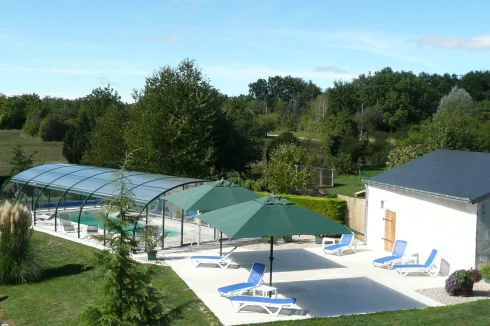Building Works and French Rental Income
Thursday 03 December 2015
Building works carried out on a French rental property are tax deductible, but the concession has some important limitations on the nature and timing of the works.
If you rent out a residential property in France, in order to arrive at a figure for net taxable rental income each year you have the choice of electing for a standard fixed cost allowance (régime micro) or to deduct actual eligible costs (régime réel).
The rule applies for both unfurnished and furnished accommodation, and to both residents and non-residents alike.
If you elect to be taxed on the basis of actual costs you can charge repair, maintenance and improvement works against rental income.
However, not all works of improvement are accepted as a deductible cost, and major construction works are expressly excluded.
The problem for any landlord is establishing the boundary line between these different types of works, and the rule that applies if they are carried out simultaneously, as is frequently the case.
Unfortunately, the law on this matter does not offer a great deal of precision.
Article 31 of the French tax code states that:
"Les charges de la propriété déductibles pour la détermination du revenu net comprennent…..
a) Les dépenses de réparation et d'entretien effectivement supportées par le propriétaire………
b) Les dépenses d'amélioration afférentes aux locaux d'habitation, à l'exclusion des frais correspondant à des travaux de construction, de reconstruction ou d'agrandissement."
There are regulations that provide more guidance, but there is no list of works that fall into each category and it is only as a result of case law that some greater level of definition has developed.
We can consider each of the works categories in turn.
Repairs and Maintenance
Repairs and maintenance are defined in the regulations as "work having as their object to maintain or restore a building to good condition and allow normal use for its intended purpose, without changing the solidity, the configuration or original amenities."
They also include "the restoration, repair or replacement of essential facilities to maintain the building capable of being used for its intended purpose."
The regulations state that the mere fact that the expense involved replacing a part or obsolete equipment with more modern equipment is not sufficient to deprive it of its character of expenditure of repair or maintenance.
Where repairs and maintenance are accompanied by improvement works then, depending on the nature of the works, the whole may be considered to be improvement works.
If the latter are, in turn, considered to be part of other major construction works that have been carried out, then they would not be deductible.
Improvement Works
Improvement expenses are defined in the regulations as "those that are intended to provide new or improved facilities, an increased level of comfort, or amenities better adapted to modern living, provided the works do not change the structure of the building."
Accordingly, example works that have been accepted as deductible are a new central heating system, new toilet and bathroom facilities within the property, a new kitchen within the property, a lift, and improved drainage system.
The difficulties arise when improvement works are undertaken following major construction works, or simultaneously with such works. In practice it is often difficult to separate the two elements.
The issue frequently turns on the scale of the construction works, leading to the general conclusion that where such works are relatively modest the improvements works would be separated out and accepted as deductible.
Indeed, in some cases, even the construction works may be accepted as deductible. Thus, prima facia, a bathroom extension would not be eligible, although it is quite possible the tax office would allow it if was a sensible solution to the improvement of a property, particularly if there was no alternative. The plumbing works within it would almost certainly be deductible.
Where the construction works were significant and the improvement works merely accessory, the latter have been held to be not deductible.
In addition, in another case, where improvement works could not be separated from other major construction works they were assimilated as the latter and found not to be deductible.
Clearly, in all of this, some careful wording of the estimate and the invoice by the builder might help!
Major Construction Works
Those works that are expressly not chargeable are those which either:
- Make an important change to the structure of the building;
- Improvement works that by their nature are equivalent to reconstruction of the building, or;
- Works that increase the volume or living space of the property.
The reason why major construction works are not admissible is that they lead to an increase in the value of the property, so cannot also be considered to be a deductible expense. Such works are then an eligible allowance against capital gains tax, in the event of sale of the property.
Of course, improvement works generally also lead to an increase in value, but such works are accepted as deductible in order to encourage improvement of the housing stock.
Works which have been determined to be non-deductible include full or partial demolition of a building with a view to its reconstruction; change of use of a building involving major reconstruction work; an increase in the number of units in a property involving major reconstruction of many of the structural elements of the property.
In addition, any increase in the size or height of the property is unlikely to be accepted as deductible, save where they are minor and/or necessary for the installation of modern amenities.
However, where an owner converted two en-suite bedrooms into a three roomed single apartment, without undertaking any major construction works, the works were held to be deductible by the courts.
There are particular rules governing works carried out on certain type of investment properties, such as 'Scellier' and 'Pinel' and to properties within conservation areas under the 'Loi Malraux'.
DIY Works
Works carried out on a DIY basis by the landlord are eligible, but only for the cost of the materials. You should ensure that all invoices relate to the rental property, not to your own home.
Timing of Works
In relation to an empty property in which building works are carried out to make available for letting for the first time, only those works paid in the year in which the property is let are deductible.
So building works carried out and paid in 2014 for a property let in 2015 would not be deductible. Only if the building works were paid in 2015 would the costs be deductible.
What this can frequently mean in practice is that the initial costs to prepare a property for letting are not deductible.
One possible solution here is to borrow to fund the acquisition and building works, as interest is tax deductible.
The rule is different for works carried out between lettings, when the tax authority normally allow a period of time for reletting following works.
The period allowed between lettings is a maximum of two years, but possibly less if demand in the locality for such accommodation was considered to be strong.
As always, articles of this nature are provided for general guidance only, but if you would like further information or to share your experiences you can reach us at [email protected]
Next Article: Domestic Burglaries in France
Thank you for showing an interest in our News section.
Our News section is no longer being published although our catalogue of articles remains in place.
If you found our News useful, please have a look at France Insider, our subscription based News service with in-depth analysis, or our authoritative Guides to France.
If you require advice and assistance with the purchase of French property and moving to France, then take a look at the France Insider Property Clinic.





